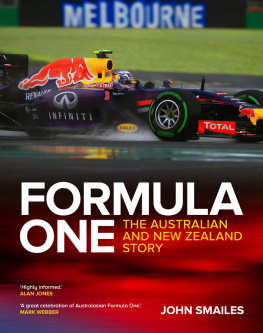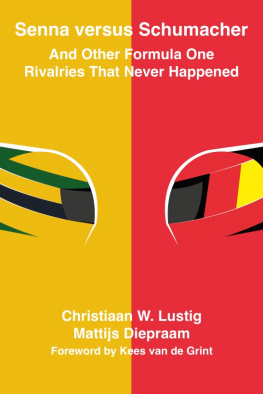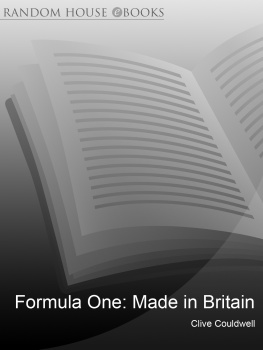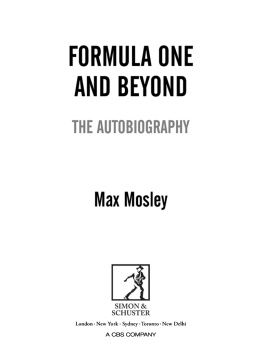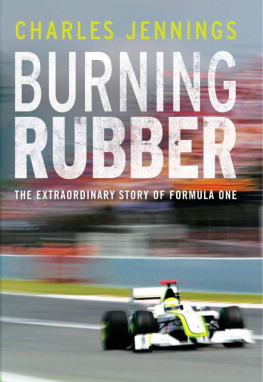To Jean Brawn and Emmanuelle Parr
GLOSSARY OF KEY NAMES AND TERMS
Bernie Ecclestone | Chief Executive of the Commercial Rights Holder since 1978. |
Charlie Whiting | Officially, FIA Race Director and Safety Delegate since 1997; in effect, the Chief Technical Officer of Formula One. |
Christian Horner | Team Principal of the Red Bull F1 team. |
Clarifications | A process by which F1 teams seek confidential guidance from the FIA concerning the legality of a design under the Technical Regulations. |
Colin Kolles | Former Team Principal of the F1 team that competed as Jordan, Midland, Spyker and Force India from 2005 to 2008. |
Commercial Rights Holder | The owner of the commercial rights in Formula One, variously known as the Formula One Group, of which Bernie Ecclestone is Chief Executive. |
Concorde Agreements | The name given to the three-way contracts between the F1 teams, the Commercial Rights Holder and the FIA. These agreements determine how revenues are shared and rules made. They also determine what components of a car must be designed by each Constructor. Until the end of 2012, there was one agreement signed by all the parties. The current agreements began on 1 January 2013 and expire on 31 December 2020. |
CVC | The private equity group that acquired Formula One in 2006 and remains the controlling shareholder. The managing partner of CVC is Donald Mackenzie. |
Dietrich Mateschitz | Co-founder and Chairman of Red Bull. |
Dieter Zetsche | Chairman of the Board of Directors of Daimler AG and Head of Mercedes-Benz Cars since 2006. |
Downforce | The force produced when an F1 car moves through the air, forcing the car into the ground. The opposite of lift produced by an aircraft. The penalty of downforce is energy-sapping drag so the holy grail of F1 aerodynamics is to maximize downforce and minimize drag, enabling the car to corner faster with high straight line speed. |
FIA | The Fdration Internationale de l'Automobile, owner and regulator of Formula One. |
Flavio Briatore | Team Principal of the Benetton and then Renault F1 teams from 1994 until 2009. |
FOTA | The Formula One Teams Association, which represented all the teams between 2009 and its collapse in 2013. |
Frank Williams | Founder and Team Principal of the Williams F1 team. |
Jean Todt | President of the FIA since 2009. Formerly, Team Principal of the Scuderia Ferrari from 1994 to 2006, and CEO of Ferrari from 2006 to 2009. |
John Barnard | F1 designer and technical director whose career overlapped with Ross Brawns at Benetton and then Ferrari. During his second stint at Ferrari in the mid-1990s, Barnards design office was located in Surrey, England. |
Luca di Montezemolo | President and then Chairman of Ferrari between 1991 and 2014. |
Martin Whitmarsh | Team Principal of the McLaren F1 team from 2009 to 2014, where he was Managing Director from 1997. |
Max Mosley | President of the FIA between 1993 and 2009. |
Nick Fry | Chief executive of the Brackley-based F1 team that went through several incarnations as BAR, Honda, Brawn and Mercedes. Commercial partner, and fellow shareholder, with Ross Brawn of the Brawn GP team. |
Niki Lauda | Chairman of the Mercedes F1 team and former F1 World Champion. |
Pat Symonds | Chief Technical Officer of the Williams F1 team. Formerly Michael Schumachers race engineer at the Benetton F1 team and then technical director at Benetton, which became the Renault F1, where Symonds served as Director of Engineering until 2009. |
Patrick Head | Co-founder and Director of Engineering of the Williams F1 Team. |
Ron Dennis | Shareholder, CEO and chairman of the McLaren Technology Group which includes the F1 team and McLaren roadcars. |
Rory Byrne | Chief Designer at Benetton between 1991 and 1996 and Ferrari between 1997 and 2006. |
RRA | The Resource Restriction Agreement, a cost control measure introduced by FOTA in 2009 and which collapsed in 2013. |
Sporting Regulations | The FIAs rules that govern the Grand Prix events. |
Technical Regulations | The FIAs technical rules that govern the design of F1 cars. |
Toto Wolff | Head of Mercedes Motorsport since 2013. Investor in Williams F1 2009 to 2013. |
SOME KEY MOMENTS IN FORMULA ONE DURING THE BRAWN ERA
The 1970s
Formula One in the 1970s is a battle primarily between Ferrari and the British garagiste teams: Lotus, Tyrrell, Brabham, McLaren and later Williams. The multiple championship winning drivers of this decade are Jackie Stewart, Emerson Fittipaldi and Niki Lauda.
James Hunt, in a McLaren, defeats Ferraris Niki Lauda by one point to win the politically charged and competitive 1976 season.
In 1974, Bernie Ecclestone, owner of the Brabham team, sets up the Formula One Constructors Association to represent and negotiate on behalf of the Formula One teams. This entity will become in due course the Commercial Rights Holder for Formula One.
In 1977, Max Mosley leaves the March team he has co-founded in order to become FOCAs legal advisor. Mosley and Ecclestone would dominate the sport until 2009.
Frank Williams sets up Williams Grand Prix Engineering in 1977. Powered by a Cosworth DFV engine, Williams F1 wins its first race at the British Grand Prix at Silverstone in the summer of 1979. At the end of this era the significance of aerodynamically generated downforce from the underside of the cars is discovered and cornering speeds escalate.
The 1980s
The 1980s start with the new Williams team winning with drivers Alan Jones and Keke Rosberg. Then, after an appearance by Ferrari and Brabhams Nelson Piquet, there follows a period of dominance for the McLaren team, with drivers Niki Lauda, Ayrton Senna and Alain Prost taking titles.
Concern about high cornering speeds means a regulatory flat bottom to the cars is introduced for 1983, but the genie is out of the lamp and the designers continue to find ways to recover downforce from ground effect.
Just before the start of the 1986 season, Frank Williams suffers paraplegic injuries in a road accident in the South of France. The Williams team goes on to win the Constructors titles in 1986 and 1987.
During this era, turbocharged engines dominate and more manufacturers enter the sport. Both McLaren and Williams are powered by Honda turbo engines that produced some 1,300 hp in qualifying trim. At this time, engines were replaced after qualifying.
The 1980s see some dramatic duels between team mates: Prost against Senna in the McLaren, Nigel Mansell against Nelson Piquet in the Williams.




